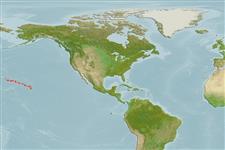Common names from other countries
Classification / Names / Names
आम नाम | उपशब्द | Catalog of Fishes (gen., sp.) | ITIS | CoL | WoRMS
Environment: milieu / climate zone / depth range / distribution range
पारिस्थितिकी
पिलाजिक; गहराई सीमा 400 - 570 m (Ref. 275). Tropical; 28°N - 16°N, 177°W - 150°W (Ref. 275)
Pacific Ocean: from Hawaiian Islands to Midway Island.
Length at first maturity / आकार / वज़न / Age
Maturity: Lm ?, range 11 - 12 cm Max length : 16.0 cm ML पुल्लिंग / अलिंग; (Ref. 275)
Mantle length at first maturity: 11.0 or 12.0 cm. Found on mid-water depths of the open ocean (Ref. 843).
Life cycle and mating behavior
परिपक्व अवधि | पुनरुत्पत्ति | मछलीऔ का अंडे देना | अंडे | Fecundity | लार्वा
Members of the class Cephalopoda are gonochoric. Male and female adults usually die shortly after spawning and brooding, respectively. Mating behavior: Males perform various displays to attract potential females for copulation. During copulation, male grasp the female and inserts the hectocotylus into the female's mantle cavity where fertilization usually occurs. Life cycle: Embryos hatch into planktonic stage and live for some time before they grow larger and take up a benthic existence as adults.
Roper, C.F.E., M.J. Sweeney and C.E. Nauen. 1984. (Ref. 275)
IUCN Red List Status (Ref. 130435)
CITES status (Ref. 108899)
Not Evaluated
Not Evaluated
Human uses
मात्स्यिकी: व्यापारिक
| FishSource |
साधन
अधिक जानकारी
Age/Size
बाढ़
Length-weight
Length-length
आकृति विज्ञान
लार्वा
बहुतायत
इंटरनेट स्रोत
Estimates based on models
Preferred temperature
(Ref.
115969): 2.6 - 10, mean 3.3 (based on 18 cells).
Vulnerability
Low vulnerability (10 of 100).
